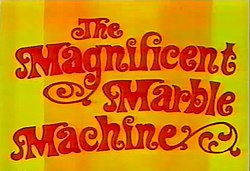The Magnificent Marble Machine (partially found Heatter-Quigley game show; 1975-1976)
The Magnificent Marble Machine was an American game show created by Merrill Heatter and Bob Quigley that revolves around its centrepiece, a giant pinball machine. It was hosted by Art James and aired on NBC from July 7, 1975, to March 12, 1976. The show was received very poorly throughout its run and a change from a civilian format to an all-celebrity format in January 1976 did help its reception or ratings. Likely due to its bad time slot and poor critical reception, very few episodes have survived.
Format
Two teams of one celebrity and one civilian start off by answering general knowledge questions, frequently involving puns or other wordplay, which were displayed on a huge electronic marquee, similar to one found on a pinball's backbox display. First, the teams were shown blanks on the display's bottom line, showing the number of words and letters in the answer; then a clue would crawl across the display's upper line. If no team buzzed in once the clue was revealed, letters of the answer then filled in at random as time progressed. James would occasionally gave an additional clue after the initial clue scrolled across the marquee. For any given question, only the contestant or the celebrity was eligible to buzz in. This alternated with each question and was indicated by lighted panels in front of the eligible player. Correct answers wins the team one point. Five points are required to win the game and the winning team played the giant pinball machine in the bonus round.
Each team member manipulated one button, each of which controlled two flippers, and tried to keep the ball in play for as long as possible within a 60-second time limit. The team accumulated points by hitting bumpers, noisemakers, and lights, and hitting any of the seven large numbered bumpers won the contestant a prize, with 2 and 3 together worth a larger prize (mainly a trip or a car). Play ended if the ball fell into one of the two outer holes. The flippers were disabled when 60 seconds expired, with the ball (still in play) usually entering an out hole within a few seconds. A bonus prize was added halfway through the series for hitting all seven numbered bumpers at least once. If a team reached a target score after playing two balls, the team played a bonus "Gold Money Ball" where the player earned $200 for each noisemaker and bumper. After the Money Ball round was removed, the electronic point counters on the pinball machine were covered over. Contestants now only played for prizes obtained by hitting the seven bumpers[1].
Cancellation
Replacing the Art James hosted Blank Check[2], the show did worse than Blank Check. Critics and viewers panned the show and did so poor in the ratings that The Young & The Restless on CBS and the Bobby Van hosted Showoffs on ABC did far better in the ratings than The Magnificent Marble Machine. The show was pulled from the schedule on January 5, 1976, in order to retool the show in an attempt to improve its critical reception and ratings. The result of two teams being both celebrities and playing for viewers at home didn't work and its poor ratings and critical reception continued until its final episode aired on March 12, 1976. The show was briefly reran from March 22 to June 11, 1976, due to a strike by the National Association of Broadcast Employees and Technicians[3]. The Fun Factory would ultimately served as its replacement on June 14, 1976.
Availability
Likely due to reusing tapes being a common practice during the time the show was on the air, the show has not resurfaced in full. Only a single episode from July 10, 1975, can be found today and a clip from the celebrity revamp can be found today. Audio of three episodes (one being from an April 30th, 1976 rerun) are confirmed to exist, though they have not been posted online[4]. A clip from an episode with Joan Rivers was used in the 1979 film The China Syndrome.
Gallery
References
- ↑ https://web.archive.org/web/20111028174347/http://loogaroo.startlogic.com/gameshow/rules/marble.shtml
- ↑ https://archive.org/details/encyclopediaofda00hyat/page/276/mode/2up
- ↑ https://www.nytimes.com/1976/04/02/archives/nbc-says-strike-cost-156000-on-first-day.html
- ↑ https://atvaudio.com/ata_search.php?keywords=MAGNIFICENT+MARBLE+MACHINE,+THE
